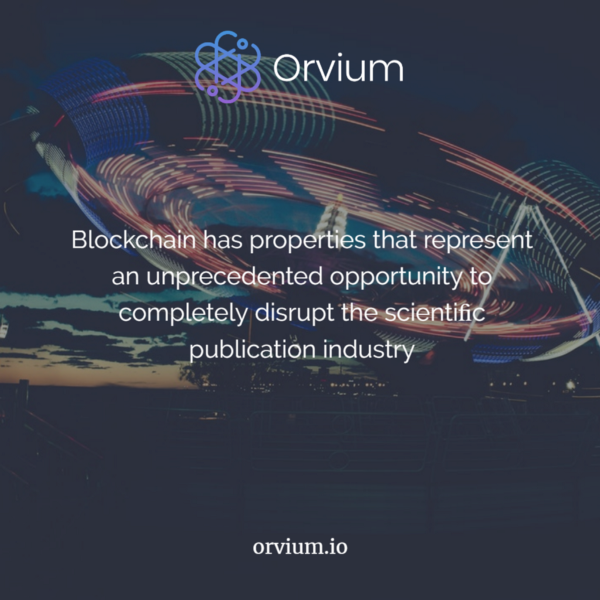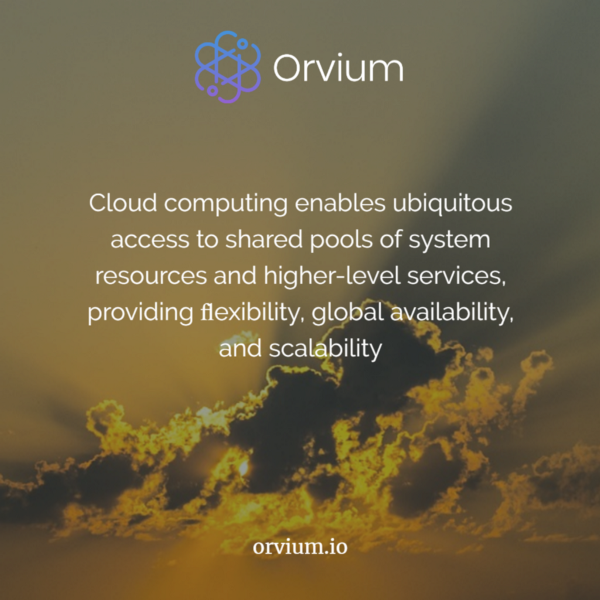How Orvium will solve the current problems in scholarly publishing and disrupt the industry (II/II)
Find out the first part of this post here.
How Orvium is Disrupting the Industry
In the last few decades, several initiatives have tried to re-engineer the scholarly publication process, but they have proved insufficient. With the rise of Blockchain, things are about to change!
Blockchain allows us to build infrastructures that enable open, trustworthy, decentralized and collaborative environments. Using this technology, researchers can submit entries into public records of information and the scientific community can control how those records are amended and updated.
In addition to its open nature, Blockchain has two other important properties: it is transparent, and it is almost impossible to corrupt or hack. These properties represent an unprecedented opportunity to completely disrupt the scientific publication industry and return the control of science dissemination to scientists while improving the way it impacts society.

Scientists get unique and seamless integration of cutting-edge technologies (Ethereum blockchain and smart contracts, decentralized storage solutions, big data analytics, and cloud computing) to create a platform to process, validate, and disseminate research data and results.
Here’s how:
Papers, reviews, reviewers, citations, authors, etc. are modelled and stored within the blockchain. Every submission, modification, and review is registered so the complete life cycle of the paper, starting from the first submission, is publicly available. This brings to life a completely new model, which introduces numerous benefits such as automatic publications, an open and transparent review process, citation checks, author validations, analytics and many others. Governance of the whole transaction system is enabled by smart contracts technology, which is the cornerstone of the new model.
Decentralized storage solutions are currently under massive development. However, protocols, such as IPFS, have proven their utility by serving billions of files across a global peer-to-peer network. These protocols are globally available, work offline, route around censorship, give permanence to digital information, have no single point of failure and nodes do not need to trust each other.

Big data analytics and machine learning technologies integrated with the Ethereum blockchain allow us to build the necessary digital infrastructure for effective management and facilitation of scientific research. Big data infrastructure enables us to join heterogeneous data sources such as transactions in the blockchain, existing research literature, and connections between researchers and publications, while machine learning unlocks valuable insights. Improved metrics including the impact factor, researcher and peer reviewer relevance, existence of citation and peer review rings, number of positive and negative reviews, number of accepted and rejected reviews and number of downloads are just some examples.
Cloud computing enables ubiquitous access to shared pools of system resources and higher-level services that can be rapidly provisioned with minimal management effort, providing flexibility, global availability, and scalability. This eliminates the fixed costs of infrastructure and boosts operational efficiency.
17 Built-In Features that Prove Orvium Is a Strong Industry Challenger
The Orvium platform is characterized by the following:
- Instantaneous proof-of-existence
- Manuscripts are available from the moment they are submitted to Orvium
- Copyright and licenses are owned and transferable by authors
- Authors retain control of their work and its potential economic benefits
- Optimal publication and access costs
- The prices are not influenced by monopolistic or oligopolistic market structures
- Efficient framework to create decentralized journals with low maintenance and operational costs
- Seamless integration between research data and results
- Continuous and transparent peer reviews
- The research community is empowered to publicly determine the validity and soundness of the research
- Public recognition and economic reward for peer reviewers
- Journal subscription freedom
- No journal subscription model is enforced
- Accommodates grey literature and its validation
- Transparent calculation of quality metrics such as impact factor and peer review quality
- Eliminates current “predatory” practices and conflicts regarding plagiarism, idea ownership and registration
- Social platform.
The platform establishes a transparent, comprehensive and competitive business model to obtain and increase revenue while supporting global research. The business model is built on the Orvium token (ORV), a new digital cryptocurrency created specifically for the platform.
Orvium’s Token Mechanics
The different phases of a manuscripts’ and journals’ life cycles (such as manuscript submission, peer review process, payments for copyright licenses, research data sharing, journal management, etc.) generates exchanges of ORV between institutions, authors, peer reviewers, journal owners, readers and any other social actor involved. This decentralization unlocks the full potential of a new, fair, transparent, and competitive market controlled by the community, free of biased oligopolies and hidden interests.
Orvium’s goal is to eliminate market inefficiencies and improve the quality and effectiveness of scientific publishing. The ultimate objective is for Orvium to be the leading publication platform for the research community while returning the benefits of science to the society. Here’s how Orvium works:
Manuscript Submission
Authors submit their manuscripts to Orvium, creating a public proof-of-existence and authorship which is stored in the blockchain. Orvium offers full traceability of the life-cycle, therefore, versioning is supported. At any moment, usually after peer reviews, authors can submit new versions of the manuscript.

At the moment of manuscript submission (initial or new version) authors can stake a number of ORV tokens to encourage and challenge the community for peer reviews. The number of paid reviews and the number of ORV tokens staked for each review will be determined by the author. These ORV tokens can be claimed by reviewers after their reviews are accepted.
Peer Review
Researchers acting as peer reviewers will submit their reviews to Orvium. This represents a change in the life-cycle of the manuscript reviewed. Therefore it will also create a public proof-of-existence and authorship of the review in the blockchain. The review proof and content will be attached to the history of the manuscript and will be public and accessible to the whole community. Orvium also introduces tools for the community to validate and act as an independent oracle for the review itself.
Publish Research Data
Authors can, at any moment, share the data used in the research. For that authors are empowered to select the licensing and copyright model that fits their case best.
Copyright and License
User licensing is entirely determined by the authors or owners. That is, they determine the rights to print, redistribute, download, translate or re-use, and they can alter these rights at any time. Depending on the license chosen, downloading or re-using the manuscript may or may not require an Orvium transaction. Authors and research institutions are free to change and exchange the copyright and licenses through the life cycle of the manuscript.




